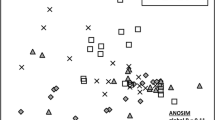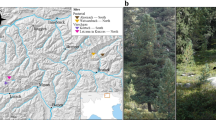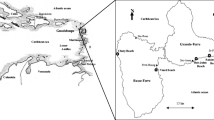Abstract
In this study, we present the detailed molecular investigation of the ectomycorrhizal (ECM) community of Quercus petraea and Quercus robur seedlings grown in bare-root forest nurseries. In all tested oak samples, mycorrhizal colonization was nearly 100%. Morphological observation and molecular investigations (sequencing of fungal ITS rDNA) revealed a total of 23 mycorrhizal taxa. The most frequent and abundant fungal taxa were Hebeloma sacchariolens, Tuber sp., and Peziza sp.; from the detected fungal taxa, 20 were noted for Q. petraea and 23 for Q. robur. Depending on the nursery, the species richness of identified ECM fungal taxa for both oak species ranged from six to 11 taxa. The mean species richness for all nurseries was 5.36 and 5.82 taxa per Q. petraea and Q. robur sample, respectively. According to the analysis of similarity, ECM fungal communities were similar for Q. petraea and Q. robur (R = 0.019; p = 0.151). On the other hand, detected fungal communities were significantly different between nurseries (R = 0.927; p < 0.0001). Using the Spearman rank correlation, it was determined that the ectomycorrhizal diversity (in terms of richness, the Shannon diversity, evenness, and Simpson dominance indices) is significantly related to the soil parameters of each nursery. We conclude that individual nursery may be considered as separate ecological niches that strongly discriminate diversity of ECM fungi.




Similar content being viewed by others
References
Agerer R (1987–2008) Colour atlas of ectomycorrhizae. Einhorn-Verlag Eduard Dietenberger, Munich
Aučina A, Rudawska M, Leski T, Skridalla A, Riepšas E, Iwański M (2007) Ectomycorrhizal colonization of Pinus sylvestris seedlings growing in nursery soil with forest litter amendment. Appl Environ Microbiol 73:4867–4873
Bencivegna M (1999) La produzione dei tartufi nei boshi di querce caducifoglie. Monti–e–Boshi 50(2):32–34
Bray JR, Curtis JT (1957) An ordination of the upland forest communities of southern Wisconsin. Ecol Monogr 27:325–349
Bruns TD (1995) Thoughts on the processes that maintain local species diversity of ectomycorrhizal fungi. Plant Soil 170:63–73
Causin R, Montecchio L, Accordi M (1996) Probability of ectomycorrhizal infection in a declining stand of common oak. Ann Sci For 53:743–752
Cavender-Bares J, Izzo A, Robinson R, Lovelock CE (2009) Changes in ectomycorrhizal community structure on two containerized oak hosts across an experimental hydrologic gradient. Mycorrhiza 19:133–142. doi:10.1007/s00572-008-0220-3
Clarke KR (1993) Non-parametric multivariate analyses of changes in community structure. Aust J Ecol 18:117–143
Colwell RK (2006) EstimateS: statistical estimation of species richness and shared species from samples. Version 8.0 User’s Guide and application persistent at: http://purl.oclc.org/estimates
Dickie IA, Koide RT, Steiner KC (2002) Influences of established trees on mycorrhizas, nutrition, and growth of Quercus rubra seedlings. Ecol Monogr 72:505–521
Dominik T (1951) Badanie mykotrofizmu roślinności wydm nadmorskich i śródlądowych. Acta Soc Bot Pol. 21:125–164 (in polish)
Driessche I van, Pierart P (1995) Ectomycorrhization and health of beeches and oaks in the forest of Soignes. Belg J Bot 128:58–70
Fujimura KE, Smith JE, Horton TR, Weber NS, Spatafora JW (2005) Pezizalean mycorrhizas and sporocarps in ponderosa pine (Pinus ponderosa) after prescribed fires in eastern Oregon, USA. Mycorrhiza 15:79–86
Garbaye J, Menez J, Wilhelm MA (1986) Les mycorrhizes des jeunes chanes dans les pepinieres et les regenerations naturelles du Nord-Est de la France. Acta Oecol Plant 7:87–96
Gardes M, Bruns TD (1996) ITS-RFLP matching for identification fungi. Meth Mol Biol 50:177–186
Hammer O, Harper DAT, Ryan PD (2001) PAST: Palaeontological statistics software package for education and data analysis. Palaeont Electron 4(1):9
Henrion B, Di Battista C, Bouchard D, Vairelles D, Thompson BD, Le Tacon F, Martin F (1994) Monitoring the persistance of Laccaria bicolor as an ectomycorrhizal symbiont of nursery—grown Douglas fir by PCR of the rDNA intergenic spacer. Mol Ecol 3:571–580
Hilszczańska D, Sierota Z, Palenzona M (2008) New Tuber species found in Poland. Mycorrhiza 18:223–226. doi:10.1007/s00572-008-0175-4
Ingleby K, Mason PA, Last F, Fleming LV (1990) Identification of ectomycorrhizas. HMSO, London
Ishida TA, Nara K, Hogetsu T (2007) Host effects on ectomycorrhizal fungal communities: insight from eight host species in mixed conifer broadleaf forests. New Phytol 174:430–440. doi:10.1111/j.1469-8137.2007.02016.x
Iwański M, Rudawska M, Leski T (2006) Mycorrhizal associations of nursery grown Scots pine (Pinus sylvestris L.) seedlings in Poland. Ann For Sci 63:715–723
Izzo A, Agbowo J, Bruns TD (2005) Detection of plot level changes in ectomycorrhizal communities across years in an old growth mixed conifer forest. New Phytol 166:619–629
Jalas J, Suominen J (1976) Atlas Flora Europaea Volume 3. Committee for mapping the flora of Europe and societas biologica fennica vanamo, Helsinki
Kåren O, Hogber N, Dahlberg A, Jonsson L, Nylund JE (1997) Inter- and intraspecific variation in the ITS region of rDNA of ectomycorrhizal fungi in Fennoscandia as detected by ednonuclease analisis. New Phytol 136:313–325
Kovacs G, Pausch M, Urban A (2000) Diversity of ectomycorrhizal morphotypes and oak decline. Phyton 40:109–116
Ławrynowicz M (1988) In: Flora Polska. Rośliny zarodnikowe Polski i ziem ościennych. Grzyby (mycota). Tom XVIII, Instytut Botaniki PAN, PWN Warszawa – Kraków: 161. (in polish)
Leski T, Aučina A, Rudawska M (2008) The ectomycorrhizal status of European larch (Larix decidua Mill.) seedlings from bare-root forest nurseries. For Ecol Manag 256:2136–2144. doi:10.1016/j.foreco.2008.08.004
LoBuglio KF (1999) Cenococcum geophilum. In: CCairney JWG, Chambers SM (eds) Ectomycorrhizal fungi: key genera in profile. Springer, New York, pp 287–309
Menkis A, Vasiliauskas R, Taylor AFS, Stenlid J, Finlay R (2005) Fungal communities in mycorrhizal roots of conifer seedlings in forest nurseries under different cultivation systems, assessed by morphotyping, direct sequencing, and mycelial isolation. Mycorrhiza 16:33–41. doi:10.1007/s00572-005-0011-z
Meyer FH (1973) Distribution of ectomycorrhizae in native and man-made forests. In: Marks GC, Kozlowski TT (eds) Ectomycorrhizae. Their Ecology and Physiology. Academic Press, London, pp 79–105
Moreau PA, Peintner U, Gardes M (2006) Phylogeny of the ectomycorrhizal mushroom genus Alnicola (Basidiomycota, Cortinariaceae) based on rDNA sequences with special emphasis on host specifcity and morphological characters. Mol Phyl Evol 38:794–807
Morris MH, Smith ME, Rizzo DM, Rejmánek M, Bledose CS (2008) Contrasting ectomycorrhizal fungal communities on the roots of co-occurring oaks (Quercus spp.) in a California woodland. New Phytol 178:167–176. doi:10/1111/j.1469-8137.2007.02348.x
Mosca E, Montecchio L, Sella L, Garbaye J (2007) Short – term effect of removing tree competition on the ectomycorrhizal status of a declining pedunculate oak forest (Quercus robur L). For Ecol Manag 244:129–140. doi:10.1016/j.foreco.2007.04.0019
Moser AM, Frank JL, D’Allura JA, Southworth D (2009) Ectomycorrhizal communities of Quercus garryana are similar on serpentine and nonserpentine soils. Plant Soil 315:1850194. doi:10.1007/ s11104-008-9743-9
Pachlewski R, Gągalska J (1953) Badanie mykotrofizmu dębów na terenie Polski z uwzględnieniem warunków bioekologicznych. Acta Soc Bot Pol. 22(3):561–576 (in polish)
Pallardy SG (2007) Physiology of Woody Plants, 3rd edn. Academic Press, San Diego
Perry DA, Molina R, Amaranthus MP (1987) Mycorrhizae, mycorrhizospheres, and reforestation: current knowledge and research needs. Can J For Res 17:929–940
Richard F, Millot S, Gardes M, Selosse M-A (2005) Diversity and specificity of ectomycorrhizal fungi retrieved from an old-growth Mediterranean forest dominated by Quercus ilex. New Phytol 166:1011–1023
Rudawska M, Leski T, Gornowicz R (2001) Mycorrhizal status of Pinus sylvestris L. nursery stock in Poland as influenced by nitrogen fertilization. Dendrobiology 46:49–58
Rudawska M, Leski T, Trocha LK, Gornowicz R (2006) Ectomycorrhizal status spruce seedlings from bare-root forest nurseries. For Ecol Manag 236:375–384. doi:10.1016/j.foreco.2006.09.066
Simard SW, Perry DA, Smith JE, Molina R (1997) Effect of soil trenching on occurrence of ectomycorrhizas on Pseudotsuga menziesii seedlings grown in mature forests of Betula papyrifera and Pseudotsuga menziesii. New Phytol 136:327–340
Smith SE, Read DJ (2008) Mycorrhizal symbiosis, 3rd edn. Academic Press, San Diego
Southworth D, Carrington EM, Frank JL, Gould P, Harrington CA, Davine WD (2009) Mycorrhizas on nursery and field seedlings of Quercus garryana. Mycorrhiza 19:149–158. doi:10.1007/s00572-008-0222-1
Tedersoo L, Kõljalg U, Hallenberg N, Larsson KH (2003) Fine scale distribution of ectomycorrhizal fungi and roots across substrate layers including coarse woody debris in a mixed forest. New Phytol 159:153–165
Tedersoo L, Hansen K, Perry BA, Kjoller R (2006) Molecular and morphological diversity of pezizalean ectomycorrhiza. New Phytol 170:581–596
Timonen S, Kauppinen P (2008) Mycorrhizal colonization patterns of Tilia trees in street, nursery, and forest habitats in southern Finland. Urban For Urban Green 7:265–276. doi:10.1016/j.ufug.2008.08.001
Trappe JM (1962) Fungus associates of ectotrophic mycorrhizae. Bot Rev 28:538–606
Trocha LK, Rudawska M, Leski T, Dabert M (2006) Genetic diversity of naturally established ectomycorrhizal fungi on Norway spruce seedlings under nursery conditions. Microb Ecol 52:418–425. doi:10.1007/s00248-006-9110-4
Urban A, Neuner-Plattner I, Krisai-Greilhuber I, Haselwandter K (2004) Molecular studies on terricolous microfungi reveal novel anamorphs of two Tuber species. Mycol Res 108:749–758
Urban A, Puschenreiter M, Strauss J, Gorfer M (2008) Diversity and ectomycorrhizal and co-associated fungal communities in serpentine soil. Mycorrhiza 18:339–534. doi:10/1007/s00572-008-0189-y
Ursic M, Peterson RL (1997) Morphological and anatomical characterization of ectomycorrhizas and ectendomycorrhizas on Pinus strobus seedlings in a southern Ontario nursery. Can J Bot 75:2057–2072
Valentine LL, Fiedler TL, Hart AN, Peterson CA, Berninghausen HK, Southworth D (2004) Diversity of ectomycorrhizas associated with Quercus garryana in southern Oregon. Can J Bot 82:123–135. doi:10.1139/b03-117
Van den Driessche R (1984) Relationship between spacing and nitrogen fertilization of seedlings in the nursery, seedling mineral nutrition, and outplanting performance. Can J For Res 14:431–436
Voiry H (1981) Classification morphologique des ectomycorhizes du chêne et du hêtre dans le nord-est de la France. Eur J For Path 11:284–299
Vrålstad T, Fossheim T, Schumacher T (2000) Piceirhiza bicolorata—the ectomycorrhizal expression of the Hymenoscyphus ericae aggregate? New Phytol 145:549–563
Vrålstad T, Myhre E, Schumacher T (2002) Molecular diversity and phylogenetic affinities of symbiotic root-associated ascomycetes of the Helotiales in burnt and metal polluted habitats. New Phytol 155:131–148
Walker JF, Miller OK Jr, Horton JL (2005) Hyperdiversity of ectomycorrhizal fungus assemblages on oak seedlings in mixed forests in the southern Appalachian Mountains. Mol Ecol 14:829–838
Walker JF, Miller OK Jr, Horton JL (2008) Seasonal dynamics of ectomycorrhizal fungus assemblages on oak seedlings in southtern Appalachian Mountains. Mycorhhiza 18:123–132. doi:10.1007/s00572-008-0163-8
Zajączkowski P (2008) Duże wypierają małe. Las Polski 7:14–15 (in polish)
Acknowledgments
This study was supported by Institute of Dendrology Polish Academy of Sciences. We thank the Board of State Forest Districts in Gdańsk, Olsztyn, and Poznań and forest nursery staffs for the supply of experimental material and their help with fieldwork and in assembling background information. Prof. Jacek Oleksyn and two anonymous reviewers contributed valuable comments on final version of this manuscript.
Author information
Authors and Affiliations
Corresponding author
Rights and permissions
About this article
Cite this article
Leski, T., Pietras, M. & Rudawska, M. Ectomycorrhizal fungal communities of pedunculate and sessile oak seedlings from bare-root forest nurseries. Mycorrhiza 20, 179–190 (2010). https://doi.org/10.1007/s00572-009-0278-6
Received:
Accepted:
Published:
Issue Date:
DOI: https://doi.org/10.1007/s00572-009-0278-6




